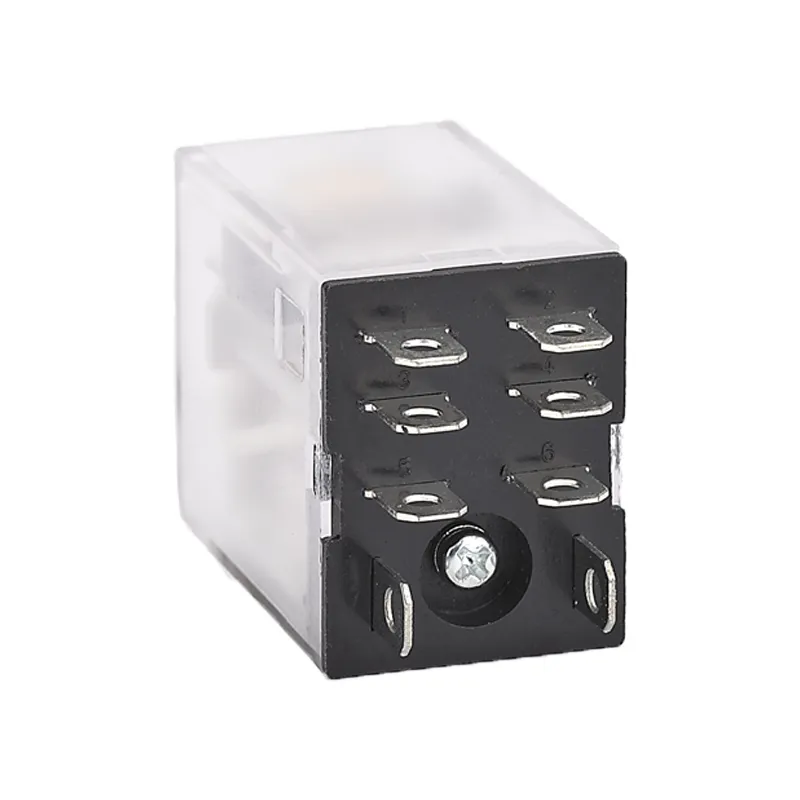What are Electromagnetic Relay 16A
HW-L1CL Electromagnetic Relay 16A is an electrical control device, mainly composed of coil, armature, contacts, etc. When the coil is energized, an electromagnetic effect is generated to attract the armature to move, thereby driving the contacts to connect or disconnect, realizing circuit control.
Electromagnetic relays can control large currents with small currents and are widely used in industrial control, household appliances, automotive electronics and other fields. Common types of relays include power relays, time relays, solid-state relays, etc.

Working principles
The working principle of Electromagnetic Relay 16A is based on the law of electromagnetic induction. When the coil is energized to generate current, a magnetic field is formed around the coil. This magnetic field attracts the armature, causing it to overcome the spring force and attract the iron core.
The movement of the armature drives the opening and closing of the contacts. The normally open contact changes from the disconnected state to the connected state, and the normally closed contact changes from the connected state to the disconnected state. When the coil is de-energized, the magnetic field disappears, the armature is reset under the action of the spring, and the contacts return to their initial state.
By controlling the on and off of the coil, the circuit can be connected and disconnected. This “small controlling large” feature makes the relay a key component of the automation control system.
Electromagnetic Relay 16A Advantages and disadvantages
Advantages:
- It can achieve electrical isolation and control high-power circuits with small signals.
- The contact parameters are diverse and can be selected according to load requirements.
- Low price, many varieties and specifications, easy to choose.
- Reliable operation, long life, and can be started frequently.
Disadvantages:
- The action speed is slow and not suitable for high-frequency switching.
- Large volume, high power consumption, and obvious heat generation.
- The contacts are easily oxidized and need regular maintenance.
- It is sensitive to vibration and impact and easy to be damaged.

Structure of Electromagnetic Relay 16A
The main structure of Electromagnetic Relay 16A includes:
1. Iron core, coil: The coil is wound on the iron core and generates an electromagnetic field when powered. This is the core component of the relay.
2. Armature: A movable iron piece that moves when attracted by electromagnetic force.
3. Contact spring: It includes static contacts and moving contacts, which are connected or disconnected by the armature.
- Normally open contact: The coil is in an open state when it is not powered
- Normally closed contact: The coil is in a closed state when it is not powered
4. Return spring: The armature returns to its initial position after the coil is powered off.
5. Support, pin: Used to fix and connect the housing and leads of the relay.
What are the common uses of Electromagnetic Relay 16A in practical applications
Industrial control: In electrical control circuits, relays are used to connect or disconnect control loops to control actuators such as motors and valves.
Household appliances: Relays are used in control circuits such as compressor start-up and motor speed regulation in home appliances such as air conditioners and refrigerators.
Automotive electronics: Automotive relays are used to control electrical equipment such as lights, wipers, horns, and starters.
Communication equipment: Signal relays are used to switch, switch, and amplify signals in communication systems.
Security systems: Relays are used to trigger alarms and control door locks in anti-theft alarms and access control systems.
Medical equipment: Relays are used to switch and isolate different circuit modules in medical instruments.

Maintenance and care of Electromagnetic Relay 16A
To ensure the reliable operation of Electromagnetic Relay 16A, daily maintenance is required:
- Check the contacts regularly to ensure good contact, no oxidation and ablation. Polish with fine sandpaper if necessary.
- Check the coil insulation, measure the coil resistance, and confirm that there is no short circuit or open circuit fault.
- Clean the dust on the surface of the relay, keep the shell clean and dry, and avoid moisture.
- Check the fastener to ensure that the screws, terminals, etc. are connected reliably to avoid looseness.
- According to the frequency of use of the relay, replace aging springs and contacts regularly.
- Avoid excessive impact and vibration of the relay, and take shock-absorbing measures if necessary.
In short, although the electromagnetic relay has a simple structure, it is indispensable in the electrical control system. Mastering the working principle, selection method and maintenance points of the relay is crucial to designing a safe and reliable control circuit.


